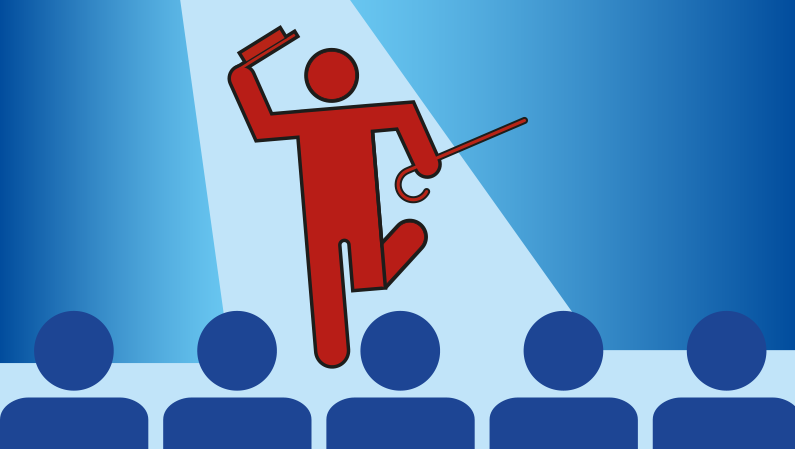How do you become a good presenter? If you’re not a natural or comfortable with being on stage, can you then learn to be a great presenter?
YES you can. Thorough planning can help you a long way. Read my article with tips about what works in presenting – and what doesn’t. Here I will give you both the simple and general tips.
Cold sweat on your forehead, butterflies in your stomach and the imminent feeling that you’re dying of fright any moment… This is how you can feel when you’re about to present. If you’re not a natural on a stage, do read my 11 tips to become a better presenter.
It just may be that you’re an experienced presenter. Then you could skip this article. But – if you’re curious, you could also read my seven “Don’ts” further below. I have listed these after having listened to several speakers during my long career. Maybe you are a subject to one or two of these yourself?
Here are 11 tips on how to become a better presenter:

From Pixabay
1. Make a visual draft
Use pen and paper to “draw your presentation” before you create it. That way you need to “see” the story and the essence of what you want to talk about.
- Where will you start?
- What should you remember to include?
- Where do you want to end?
If you’re not good at drawing, then use boxes and words. Most important is to see the flow and where you want to go.
2. Be 100% focused on the topic of your presentation
To build a presentation is somewhat like writing an article. Stick to the topic you have chosen. Don’t try to tell ten different stories at the same time. Don’t write exactly what you want to talk about but something that supports your point.
3. Create a folder to the content for your presentation on you pc/Mac
Because you made a visual draft, you most likely know which pictures and screen shots you would like to use. So create a folder and place them there. That way you won’t have to search in different folders for your media, which saves you time in the planning phase.
4. When your overall idea is ready, start building your presentation
And just like with blogs and articles it’s a good idea to do a draft, and then leave it. Don’t edit until later. When your presentation has “simmered on the stove overnight”, then it’s time to edit and revise it again
5. Try an alternative to PowerPoint – create your presentation for instance in Sway
If you want to capture the attention of your audience, try a visual tool that will make them remember what they have seen. If you use Sway, there are two important things to bear in mind:
- You need to be connected to the internet to present it
- You need to click through the presentation using your keyboard, not a clicker
- F11 will get you into presenter mode
If you never heard about Sway, here is a good place to start

6. Now it’s time to practise
Practise, practise and then practise. Use your cat, your dog, your partner or your kids as your audience
7. Set the timer when you practise
You’ve been given a certain amount of time for your presentation. Therefore, it’s important to use this amount of time. No more and no less. Think about the ones presenting after you and don’t eat 20 minutes of their time. If you are the last speaker, then it’s your loss when time is up and you didn’t get to say all you wanted. Ask the people that invited you to give you time signals, if you speak somewhere without time running on the monitors
8. On the day of your presentation
Eat and drink!. Don’t come to your presentation with an empty stomach. If possible at all, see if you can answer the call of nature when you’re at home. No fun to be blue in your face and look like you are going to explode, because you didn’t catch the bathroom 🙂
9. Technology check! Arrive well ahead of schedule to see that everything works
- If your presentation relies on wifi, then setup a hotspot via your mobile phone, so you have internet access if the wifi doesn’t work at the location. Note down how you did it. If you’re not used to do this and you are nervous, you can easily forget how to set it up.
- You may want to have your presentation on an USB or download an offline version of your presentation to your folder if possible.
- Remember to charge your moblie phone and pc/Mac in advance
- Check which cables, plugs and wires it takes to connect your pc/mac with the projector/screen
10. Breathe and gather your thoughts before you head on stage
Find a quiet room and take a couple of deep breaths. Focus on all the positive things connected with you presenting something you are dedicated to.
11. Enjoy the moment and ask the audience a question
Start thanking those who invited you or introduce you. Then ask the audience a relevant question. Thus you engage them and hopefully you relax a bit the first 10-15 seconds before your presentation starts. Use humour if you can. Don’t take it all too seriously. You’re a human being. And so is your audience.
More good advice about presenting
There are many presentation experts out there. I can recommend following David McGimpsey, who has inspired me to several of the above-mentioned advice. He has great articles and tips on his website.
What should you avoid doing? Are you one of those presenters who always start with an excuse? Fall in love with one person in the audience? Read on…
I have been sitting among the audience and attended several presentations during my long working life. Both those that were inspiring and epic. I especially remember the photographer Platon who enchanted me and 400 others with his stories about all the known and less known people he has photographed during his career.
But I have also witnessed some really akward presentations.
Here are seven tips about what NOT to do when you present

From Pixabay
1. Start with an excuse
Try to notice how many who actually start their speech with an excuse! It’s the first thing they say before they even start presenting. But why? You make yourself less worthy by making an excuse. Here are some of the excuses I have heard:
- “I don’t speak so loud today, because my throat hurts” (The audience can most likely hear you though you have a cold).
- “I am sorry for being late, but the bus was stuck in a drift of snow” (You are of course arriving well ahead of schedule and plan according to the weather conditions)
- “I’m sorry, I haven’t prepared that thoroughly” (You are just NOT saying this? You will of course prepare thoroughly unless you were summoned an hour before the presentation because the original speaker has the flu. If that is the case, it is quite allright to start with an excuse)
2. Look at the screen when you are presenting
If you look at the screen, you turn the back to your audience. And then I cannot hear what you are saying, unless I am sitting on the first two-three rows. You’re letting me down by turning your back
3. Read the bullets from your slides
Instead tell the story that supports what is in your presentation. Again, if you are reading bullets, then you turn your back to me
4. “Fall in love” with a particular person in the audience
Some have a tendency to fall in love with one or two people in the audience. I know it is not a conscious decision, but you should make sure that you give attention to everyone.
5. Speak in a monotone voice
Does your audience look as if they are falling asleep? Maybe you are speaking in a tedious voice, so remember varietyl If you have time, you can record your speech prior to you presenting. Use an app on your phone. Listen to see if your voice is monotonous or varied.
6. Stand like a statue in the same spot
When you’re on stage, walk around a bit if you can. The other extreme is “Steve Ballmer on speed”, and you probably don’t want to go there unless you are….Steve Ballmer!
7. Make your audience fall asleep
It is a thankless job to be number six in a row of speakers and your slot is after lunch on the second day of a packed seminar. But it is not that hard to put the energy back in the room and I wonder why more people are not using this simple trick:
Put a great dance video or a funky dance song into your presentation, even though you are presenting something technically heavy or academic. Boom! Surprise them. Make your audience stand up and instruct them in a simple little dance – then dance with them. I promise you we will wake up, if you pull this off. And you will appear as the one who really stood out and made a difference.
Would you like to become a better presenter?

Foto: MIkael Matzen
- If you’re going to present, book me for a mentor session in the preparation phase. We will brainstorm together and prepare you for doing a great presentation
- If you want honest and constructive feedback on yourself as a speaker, then invite me for your next speech (applies to the Øresund Region in Denmark/Sweden or via weblink.) I will give you my observations afterwards and you can use these to become a better speaker
- Need a Sway? Book me to create it for you
Do you have other great advice about presenting or about what not to do? Let me hear your comment below.


What a great article, and thanks for the mention, Anette! The number 4 don’t resonates with me because this is one I still have to keep front of mind… It’s so easy to slip on that one and focus on that friendly face at the front of the room!
David, I am so glad you like it. You’re the Man when it comes to presentation, so that coming from you means an extra special much to me! 🙂
Well considered advice from a true professional!
Robert, those words coming from you mean the world to me! Thank you so much